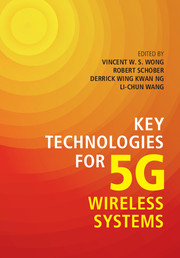Book contents
- Frontmatter
- Contents
- List of Contributors
- Preface
- 1 Overview of New Technologies for 5G Systems
- Part I Communication Network Architectures for 5G Systems
- 2 Cloud Radio Access Networks for 5G Systems
- 3 Fronthaul-Aware Design for Cloud Radio Access Networks
- 4 Mobile Edge Computing
- 5 Decentralized Radio Resource Management for Dense Heterogeneous Wireless Networks
- Part II Physical Layer Communication Techniques
- Part III Network Protocols, Algorithms, and Design
- Index
- References
3 - Fronthaul-Aware Design for Cloud Radio Access Networks
from Part I - Communication Network Architectures for 5G Systems
Published online by Cambridge University Press: 28 April 2017
- Frontmatter
- Contents
- List of Contributors
- Preface
- 1 Overview of New Technologies for 5G Systems
- Part I Communication Network Architectures for 5G Systems
- 2 Cloud Radio Access Networks for 5G Systems
- 3 Fronthaul-Aware Design for Cloud Radio Access Networks
- 4 Mobile Edge Computing
- 5 Decentralized Radio Resource Management for Dense Heterogeneous Wireless Networks
- Part II Physical Layer Communication Techniques
- Part III Network Protocols, Algorithms, and Design
- Index
- References
Summary
Introduction
The cloud radio access network (C-RAN) is an emerging paradigm for fifth generation (5G) wireless cellular networks, according to which the traditional physical layer base station (BS) transmission and reception infrastructure is virtualized using cloud computing techniques. The virtualization of wireless access also enables centralized control and management of wireless access points, which provides significant benefit from a transmission spectral efficiency perspective. In the current third generation (3G) and fourth generation (4G) cellular networks, each user, also called the user equipment or UE, is served solely by its own BS. This traditional single-cell processing paradigm, shown in Figure 3.1, suffers from considerable intercell interference, especially for cell edge users. In the C-RAN paradigm shown in Figure 3.2, as the BSs are coordinated centrally from the cloud, they can potentially transmit and receive radio signals to/from users jointly, thereby creating the possibility for interference cancellation, which can significantly improve the overall network throughput.
In a C-RAN architecture, the traditional BSs essentially become remote radio heads (RRHs) that serve to relay information between the mobile users and the central processor (CP) in the cloud. Baseband processing, together with its associated decoding/encoding complexities, is implemented in the cloud rather than taking place locally at each BS as in traditional 3G/4G networks. As the RRHs in C-RAN require only rudimentary wireless access capabilities, they are much more cost-effective to deploy, therefore allowing the C-RAN architecture to be more easily scaled geographically, leading to denser deployment of remote antennas and the ability of the network to support many more users. Furthermore, as baseband units (BBUs) are now implemented centrally at the CP, the C-RAN architecture allows the pooling of computational resources across the entire network, leading to better utilization of the computational units and higher energy efficiency for the network.
Because of both the distributed nature of wireless antenna placement and the centralized nature of cloud computing resources in C-RAN, the communication links between the RRHs and the CP are of central importance in C-RAN design. These links are often referred to as fronthaul links, as they connect the radio front end with the BBUs implemented in the cloud (in contrast to the backhaul links between the traditional 3G/4G BSs and the backbone network).
Information
- Type
- Chapter
- Information
- Key Technologies for 5G Wireless Systems , pp. 48 - 75Publisher: Cambridge University PressPrint publication year: 2017
References
Accessibility standard: Unknown
Why this information is here
This section outlines the accessibility features of this content - including support for screen readers, full keyboard navigation and high-contrast display options. This may not be relevant for you.Accessibility Information
- 5
- Cited by
